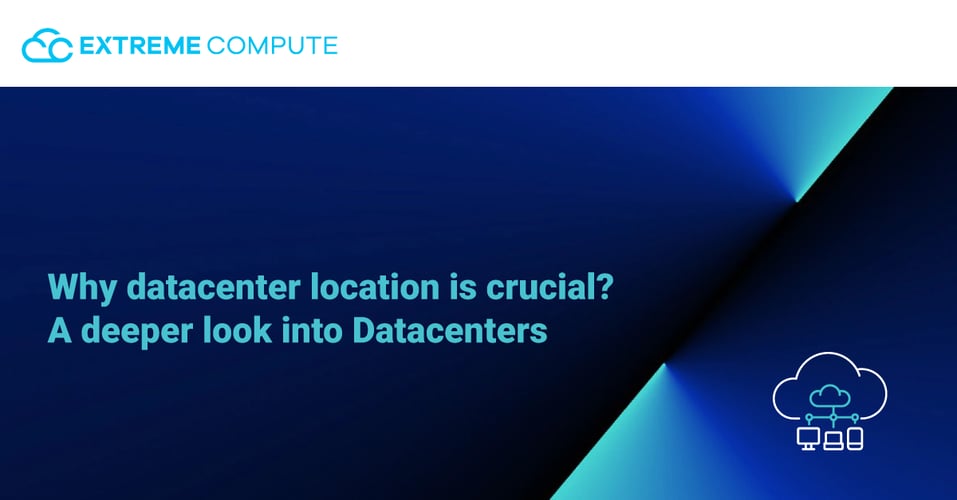Why datacenter location is crucial ? A deeper look into Datacenters
 A Datacenter with power and connectivity can be constructed anywhere, but the location has an impact on the quality of service it can provide to its customers. In order to cope with digital transformation and the resulting mountains of information and bandwidth demands, more and more businesses–across all sectors–are shifting servers to data centers outside their organizations, enabling benefits such as flexibility in infrastructure, improved recovery options, improved collaboration structures, accessibility of employees, easy access to public cloud operators.
A Datacenter with power and connectivity can be constructed anywhere, but the location has an impact on the quality of service it can provide to its customers. In order to cope with digital transformation and the resulting mountains of information and bandwidth demands, more and more businesses–across all sectors–are shifting servers to data centers outside their organizations, enabling benefits such as flexibility in infrastructure, improved recovery options, improved collaboration structures, accessibility of employees, easy access to public cloud operators.
Now that the data center conundrum is no longer "build vs buy" complexity and capacity challenges have known that "buy" won that particular war— the question has become
- "Which partner do I trust" for enterprises?"
- "Where are their data centers located, and most significantly,?”.
While selecting a technology partner, location is arguably the key consideration in addition to price, scalability, uptime and reliability. Good location choices mean an integrated network and software ecosystem that can reach your entire audience, or a game-changing data analytics approach that lets you better understand your activities and customers than competitors. Bad position on the flipside can lead to poor connections and problems with performance.
Quality of service:
Obviously, there is a lot to consider when choosing a partner— from physical security, disaster recovery, data center uptime assurances, service levels, scalability and reliability to ongoing support and maintenance— and businesses need to strike a balance between location being an important component of selection and making it the only consideration when looking for a datacenter provider. Having the Basics Right In principle, a datacenter with energy and connectivity can be constructed anywhere, but in practice, location has an impact on the quality of service that the facility can provide to its customers.
- For example, connectivity is a cooperative activity based on proximity. Ideal connectivity relies on multiple redundant fiber connections to major bandwidth providers, and the only way to provide consistent and reliable bandwidth at the volumes a business-grade data center needs is to create lots of connections to many different network providers. These providers' facilities tend to cluster together at major peering points, and when data centers are located in close geographic proximity to Internet exchanges, or peering points, low latency and multi-redundant bandwidth will benefit the organizations that use them.
- However, regardless of how much bandwidth a data center has access to, the physics and internet infrastructure inevitably bound its customers, i.e. data takes time to travel. Round-trip distances are usually twice the geographic length, as both the query and the answer have to cross the distance. This is crucial for any business; surveys consistently show that web users are quick to drop sites with slow page load times-people want fast access to data. The round trip time is exacerbated by the network's condition. In a straight line between sender and recipient, data almost never travels. It meanders instead through networks, routers, and switches, each of which can add latency-the closer the data center is to its customers, the lower the latency.
Additional Considerations:
A number of additional considerations need to be considered. These include local data protection laws, tax structures, access to services, availability of suitable networking tools, local infrastructure, skilled labor pool accessibility, track record and existing customers or comparison customers. Combined all these items make it very clear that the data center's physical location is significant. It is widely discussed, though, that space is running out, at least in cities. There has been a boom in the "mega data center" to cope with increasing demand, and since then, there has been increasing worldwide data center space. Data centers migrated into the suburbs due to this lack of land supply and increasing costs.
Building on the edge of big cities is not just a matter of getting the best performance at the lowest cost. To justify any investment in the future, knowledge of the national power system is needed; a thorough understanding of where the networks of fiber providers operate and the ability to provide an on-ramp connectivity solution to Public Cloud Services is essential to any company implementation today.
Businesses will look for data center providers that combine the low-cost availability of ample space and energy for hyper-efficient data centers with the availability of large and rich connectivity–the fiber virtual business needs. Such facilities are typically far enough away from city centers for disaster recovery purposes to avoid expensive city center rates, but near enough for local and international companies to be easily accessible.
Conclusion:
Is the location really all about the position of the data center? For short, no. There are many factors to consider when selecting a Colocation data center provider, including availability, reputation, facilities, support and cost. Yet, it is surely true that position is one of the most important factors. Location is critical not only because the geographic location is significant, but also because position has an effect on many other factors that are crucial to the success of the data center. To gain further insights for an informative decision, please subscribe or drop your mail id.
